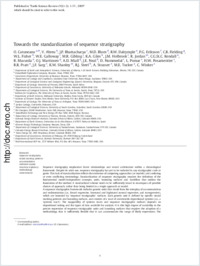Towards the standardization of sequence stratigraphy
- Catuneanu, O. Department of Earth and Atmospheric Sciences, University of Alberta, Edmonton, Canada
- Abreu, V. ExxonMobil Exploration Company, Houston, Texas, USA
- Bhattacharya, J.P. Geosciences Department, University of Houston, Texas, USA
- Blum, M.D. Department of Geology and Geophysics, Louisiana State University, Baton Rouge, USA
- Dalrymple, R.W. Department of Geological Sciences and Geological Engineering, Queen's University, Kingston, Ontario, Canada
- Eriksson, P.G. Department of Geology, University of Pretoria, South Africa
- Fielding, C.R. Department of Geosciences, University of Nebraska-Lincoln, Nebraska, USA
- Fisher, W.L. Department of Geological Sciences, The University of Texas at Austin, USA
- Galloway, W.E. Institute for Geophysics, The University of Texas at Austin, USA
- Gibling, M.R. Department of Earth Sciences, Dalhousie University, Halifax, Nova Scotia, B3H 4J1, Canada
- Giles, K.A. Institute of Tectonic Studies, New Mexico State University, Las Cruces, USA
- Holbrook, J.M. Department of Geology, The University of Texas at Arlington, USA
- Jordan, R. Jordan Geology, Centreville, Delaware, USA
- Kendall, C.G.St.C. Department of Geological Sciences, University of South Carolina, Columbia, USA
- Macurda, B. The Energists, Houston, Texas, USA
- Martinsen, O.J. StatoilHydro Technology and New Energy, Bergen, Norway
- Miall, A.D. Department of Geology, University of Toronto, Canada
- Neal, J.E. ExxonMobil Exploration Company, Houston, Texas, USA
- Nummedal, D. Colorado Energy Research Institute, Colorado School of Mines, Golden, USA
- Pomar, L. Department of Earth Sciences, Universitat de les Illes Balears, Palma de Mallorca, Spain
- Posamentier, H.W. Chevron Energy Technology Company, Houston, Texas, USA
- Pratt, B.R. Department of Geological Sciences, University of Saskatchewan, Saskatoon, Canada
- Sarg, J.F. Colorado Energy Research Institute, Colorado School of Mines, Golden, USA
- Shanley, K.W. Stone Energy, Denver, Colorado, USA
- Steel, R.J. Department of Geological Sciences, The University of Texas at Austin, USA
- Strasser, André Department of Geosciences, University of Fribourg, Switzerland
- Tucker, M.E. Department of Earth Sciences, Durham University, UK
- Winker, C. Shell International E&P Inc, Houston, Texas, USA
-
21.10.2008
Published in:
- Earth-Science Reviews. - 2009, vol. 92, no. 1-2, p. 1-33
sequence stratigraphy
stratal stacking patterns
accommodation
sediment supply
shoreline trajectory
methodology
nomenclature
English
Sequence stratigraphy emphasizes facies relationships and stratal architecture within a chronological framework. Despite its wide use, sequence stratigraphy has yet to be included in any stratigraphic code or guide. This lack of standardization reflects the existence of competing approaches (or models) and confusing or even conflicting terminology. Standardization of sequence stratigraphy requires the definition of the fundamental model-independent concepts, units, bounding surfaces and workflow that outline the foundation of the method. A standardized scheme needs to be sufficiently broad to encompass all possible choices of approach, rather than being limited to a single approach or model. A sequence stratigraphic framework includes genetic units that result from the interplay of accommodation and sedimentation (i.e., forced regressive, lowstand and highstand normal regressive, and transgressive), which are bounded by ‘sequence stratigraphic’ surfaces. Each genetic unit is defined by specific stratal stacking patterns and bounding surfaces, and consists of a tract of correlatable depositional systems (i.e., a ‘systems tract’). The mappability of systems tracts and sequence stratigraphic surfaces depends on depositional setting and the types of data available for analysis. It is this high degree of variability in the precise expression of sequence stratigraphic units and bounding surfaces that requires the adoption of a methodology that is sufficiently flexible that it can accommodate the range of likely expressions. The integration of outcrop, core, well-log and seismic data affords the optimal approach to the application of sequence stratigraphy. Missing insights from one set of data or another may limit the ‘resolution’ of the sequence stratigraphic interpretation. A standardized workflow of sequence stratigraphic analysis requires the identification of all genetic units and bounding surfaces that can be delineated objectively, at the selected scale of observation, within a stratigraphic section. Construction of this model-independent framework of genetic units and bounding surfaces ensures the success of the sequence stratigraphic method. Beyond this, the interpreter may make model-dependent choices with respect to which set of sequence stratigraphic surfaces should be elevated in importance and be selected as sequence boundaries. In practice, the succession often dictates which set of surfaces are best expressed and hold the greatest utility at defining sequence boundaries and quasi-chronostratigraphic units. The nomenclature of systems tracts and sequence stratigraphic surfaces is also model-dependent to some extent, but a standard set of terms is recommended to facilitate communication between all practitioners.
- Faculty
- Faculté des sciences et de médecine
- Department
- Département de Géosciences
- Language
-
- English
- Classification
- Palaeontology
- License
-
License undefined
- Identifiers
-
- RERO DOC 11301
- DOI 10.1016/j.earscirev.2008.10.003
- Persistent URL
- https://folia.unifr.ch/unifr/documents/300856
Statistics
Document views: 176
File downloads:
- pdf: 555
